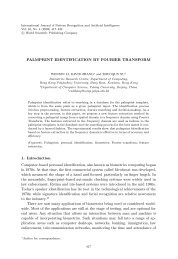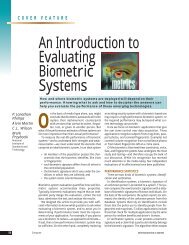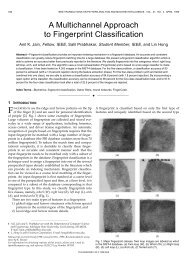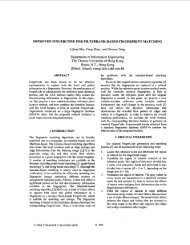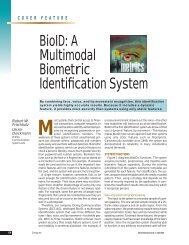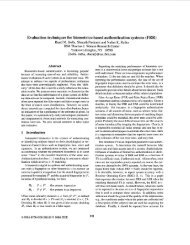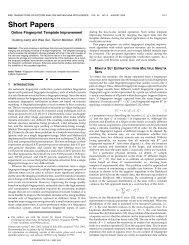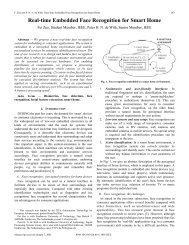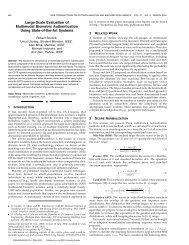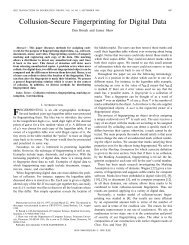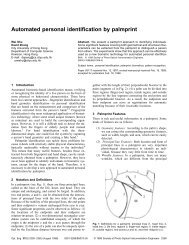Fingerprint indexing based on novel features of minutiae triplets ...
Fingerprint indexing based on novel features of minutiae triplets ...
Fingerprint indexing based on novel features of minutiae triplets ...
You also want an ePaper? Increase the reach of your titles
YUMPU automatically turns print PDFs into web optimized ePapers that Google loves.
IEEE TRANSACTIONS ON PATTERN ANALYSIS AND MACHINE INTELLIGENCE, VOL. 25, NO. 5, MAY 2003 617TABLE 1Comparis<strong>on</strong> between Germain et al.’s [4] Approach and Bhanu and Tan’s ApproachesTABLE 2NIST-4 Database Used in <str<strong>on</strong>g>Fingerprint</str<strong>on</strong>g> Recogniti<strong>on</strong> Research Publishedand identificati<strong>on</strong> is carried out during the <strong>on</strong>line stage. During the<strong>of</strong>fline stage, fingerprints in the database are processed <strong>on</strong>e-by-<strong>on</strong>eto extract <strong>minutiae</strong> [1] to c<strong>on</strong>struct model database. During the<strong>on</strong>line stage, the query image is processed by the same procedureto extract <strong>minutiae</strong>. Indexing comp<strong>on</strong>ents are derived from the<strong>triplets</strong> <strong>of</strong> <strong>minutiae</strong> locati<strong>on</strong>s and used to map the points in thefeature space to the points in the <str<strong>on</strong>g>indexing</str<strong>on</strong>g> space. The potentialcorresp<strong>on</strong>dences between the query image and images in thedatabase are searched in a local area in the <str<strong>on</strong>g>indexing</str<strong>on</strong>g> space. An<str<strong>on</strong>g>indexing</str<strong>on</strong>g> score is computed <str<strong>on</strong>g>based</str<strong>on</strong>g> <strong>on</strong> the number <strong>of</strong> trianglecorresp<strong>on</strong>dences and candidate hypotheses are generated. The topN ranked hypotheses are the result <strong>of</strong> our <str<strong>on</strong>g>indexing</str<strong>on</strong>g> algorithm.3.1 Analysis <strong>of</strong> Angle Changes Under Distorti<strong>on</strong>sWithout loss <strong>of</strong> generality, we assume that <strong>on</strong>e vertex, O, <strong>of</strong> thetriangle (see Fig. 1) is ð0; 0Þ, and it does not change under distorti<strong>on</strong>s.Since distance is invariant under translati<strong>on</strong> and rotati<strong>on</strong> andrelatively invariant under scale, and angles are defined in terms <strong>of</strong>the ratio <strong>of</strong> distance, it can be proven that angles are invariant underthese transformati<strong>on</strong>s. However, because <strong>of</strong> uncertainty <strong>of</strong> <strong>minutiae</strong>locati<strong>on</strong>s, the locati<strong>on</strong> <strong>of</strong> each vertex changes independently in asmall local area in a random manner. Suppose the locati<strong>on</strong>s <strong>of</strong> pointsA and B are ðx 1 ; 0Þ and ðx 2 ;y 2 Þ, x 1 > 0, y 2 > 0, and x 2 2 ð1; þ1Þ.We have tan ¼ y 2 =ðx 1 x 2 Þ. Because <strong>of</strong> the uncertainty <strong>of</strong><strong>minutiae</strong> locati<strong>on</strong>s, A and B move to A 0 ðx 1 þ x 1 ; 0Þ and B 0 ðx 2 þx 2 ;y 2 þ y 2 Þ; respectively, and changes to þ ; thentan ¼ððx 1 x 2 Þy 2 y 2 ðx 1 x 2 ÞÞ=ððx 1 x 2 Þ 2 þðx 1 x 2 Þðx 1 x 2 Þþy 2 2 þ y 2y 2 Þ:Suppose j x 1 x 2 j




